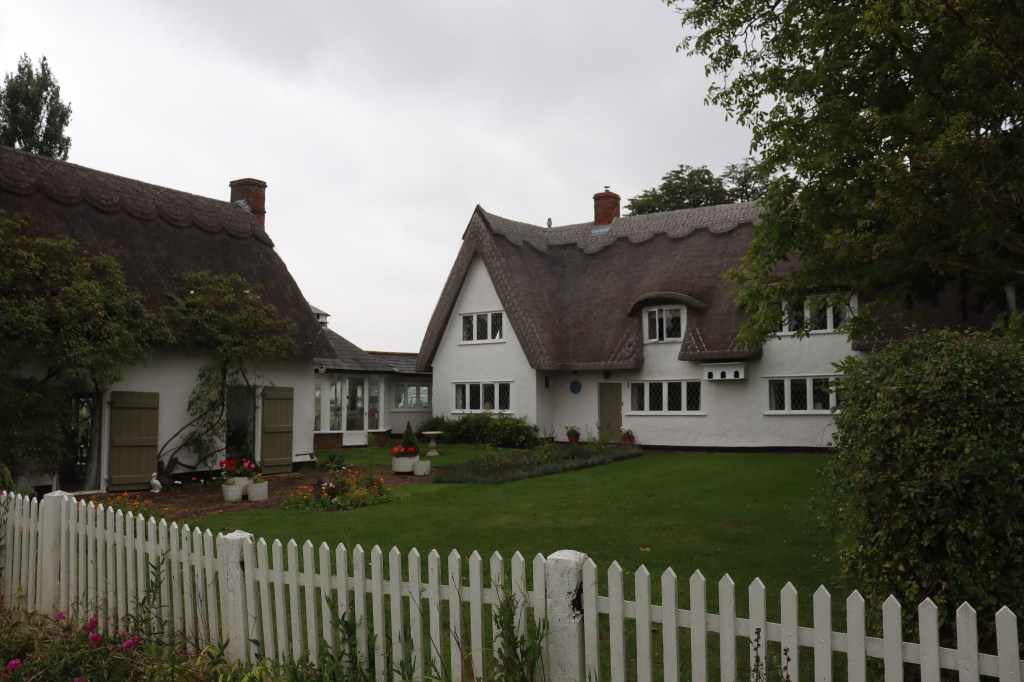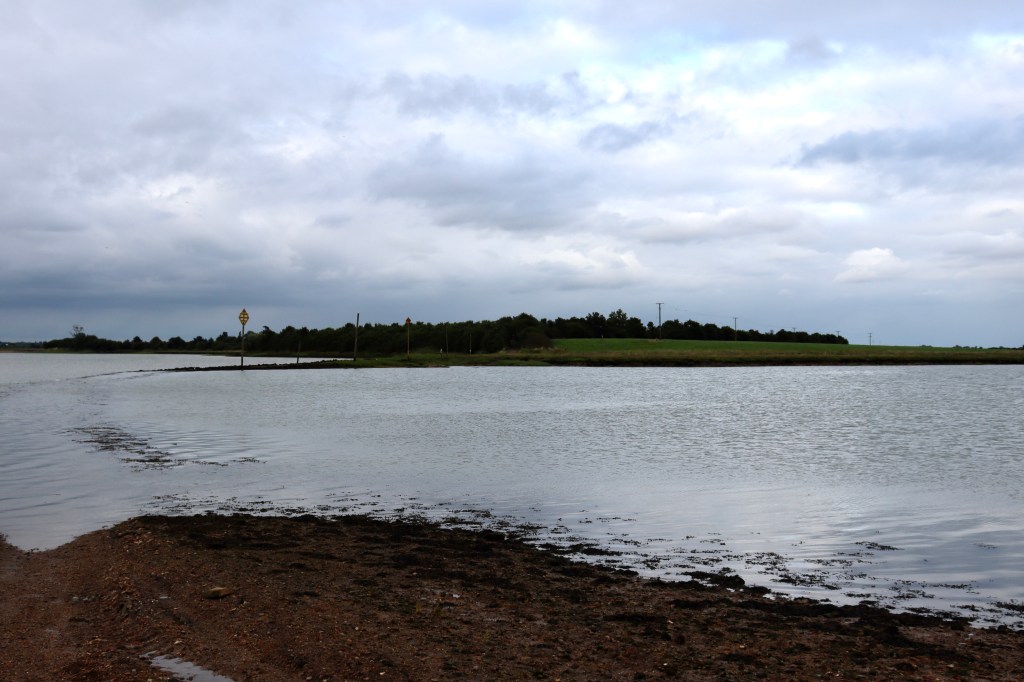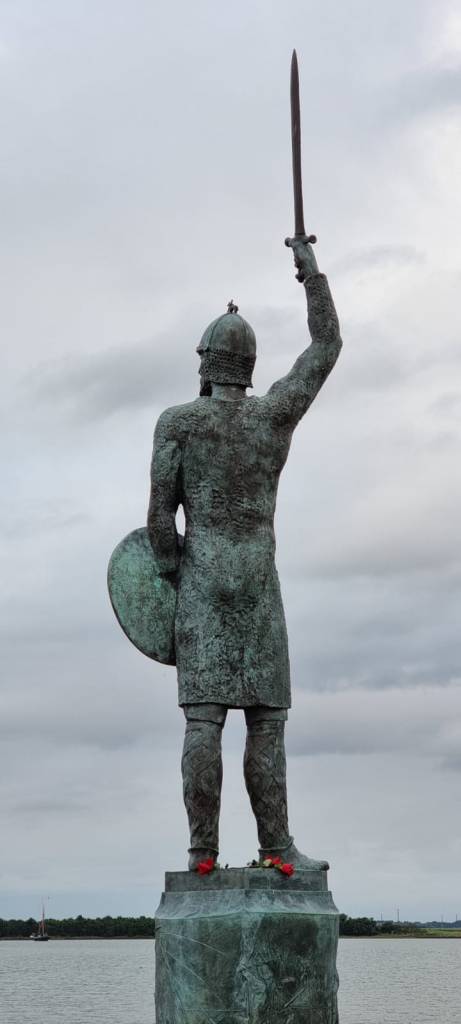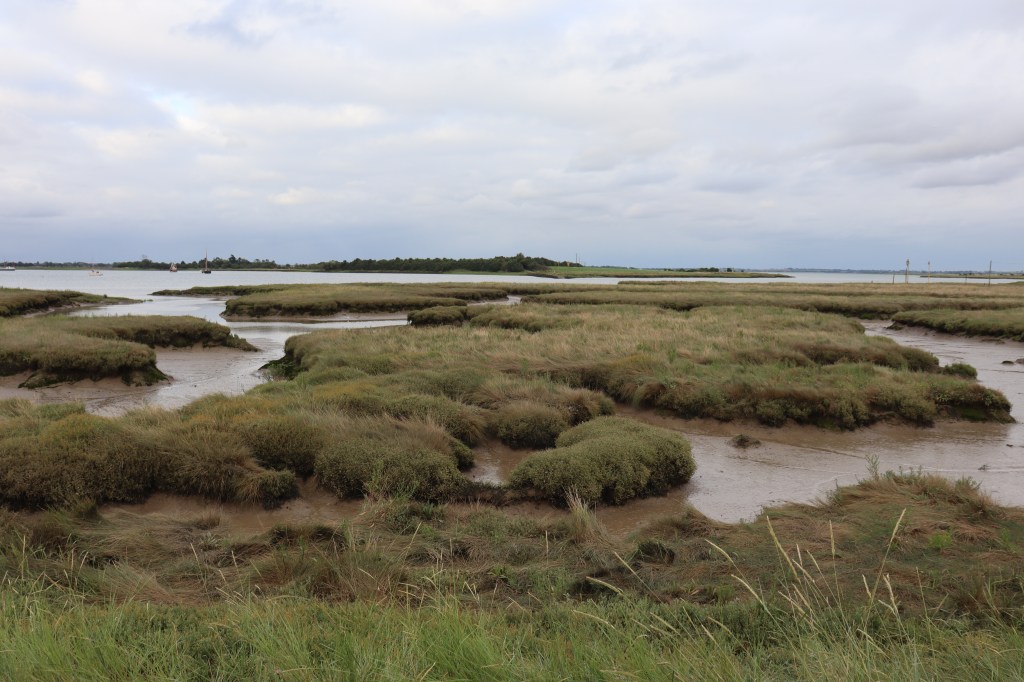It is always an absolute pleasure to drive through drive through Essex. Despite the popular media image of the county, it is heart-achingly beautiful, with it’s pretty little villages with chocolate box thatched cottages. Mrs. P and I, along with a couple of young friends of ours, went touring this much overlooked county last summer. We drove towards the coast past some gorgeous little villages. Thaxted, Flinchingfield, Howe Street, along with the wonderfully named communities of Stebbing and Steeple Bumpstead, present one with an endless array of pink-washed, half-timbered and pargetted cottages.

In Howe Street we stopped to look at the neat, white thatched cottage that was once home to Dorothy Smith. Dorothy, known as ‘Dodie’, moved here when her writing was starting to bring her success. She was primarily a playwright. Her plays, such as ‘Dear Octopus’ and ‘Call it a Day’ were enormously successful on the London stage, attracting the foremost actors of the day, along with favourable critical opinion. She was forced to move to America during the Second World War, due to her stance as a conscientious objector. She then turned to novel writing, producing her most famous works, ‘I Capture the Castle’ and ‘101 Dalmatians’, set in Sudbury, where she is commemorated with a display in the local museum.
We spent the afternoon driving towards Suffolk through Dedham Vale to take a look at Flatford Mill: the beautiful area that has been dubbed ‘Constable Country’ as it inspired the great artist to some of his best loved paintings. It was lovely to see the mill and Willy Lott’s Cottage: familiar sights from paintings in an area largely unspoilt. The National Trust do a marvellous job of keeping these areas maintained without giving in to the pressures of gift shops and cafeterias. Dedham Vale was once the home of Ruth Rendell. In there are a startling number of crime authors who have found a home in the region: PD James, Dorothy Sayers and Margery Allingham, of whom, more later. Rendell lived in the village of Polstead, also home to the infamous ‘Red Barn’, site of the murder of Maria Marten, as recreated in several popular Victorian songs and melodramas.
The village of Thrope-le-soken is another parade of pleasing old buildings. Some houses in the high street still bear the signs of a previous life in commerce, and the old bay shop fronts are still visible on many of them. There are some lovely old buildings here including a picturesque little police station, complete with blue lamp. We were staying at the Rose and Crown. A lovely, quiet little pub serving very good food with lovely, clean little rooms at an extremely reasonable price. They did us a good dinner in the evening and one of the best ‘full Englishes’ I have ever had. Freshly cooked and piping hot.
We visited Walton-on-the-naze, ostensibly to see Hamford Water, a marshy network of creeks and backwaters, that Arthur Ransome enjoyed exploring by sail. His novel, Secret Water, is set among the this vast area of muddy inlets and reeds. The plan was to walk around the point and explore the water by foot. There are boat trips that will take around the water to observe the multitude of wildlife that lives and breeds in the marshes. With the threat of Covid still a pervasive force in our everyday lives, we opted not to share a boat, crowded with several other breathing individuals, and to forego the opportunity to see seals, terns, geese and others in their natural, muddy habitat.
Mrs. P has a love of beach-combing and collecting interesting objects from the foreshore, so the morning was spent walking up and down the beach, looking at wildlife, talking to dogs, collecting fossils and glass and interesting stones.
Today, this seems to be mostly made up of caravan sites and holiday parks, so there is no shortage of visitors to this remote corner of Essex.
We drove then through Colchester and across the causeway to Mersea Island. Not a true island, it is only cut off from the mainland twice a day, when the high tide rises to cover the road. It is a patch of wooded high ground standing slightly proud of the surrounding muddy marsh. Here the Reverend Sabine Baring Gould was rector of St Nicholas Church in East Mersea.

Sabine Baring-Gould, Anglican priest, writer and scholar, spent ten years presiding over the marshy residents of Mersea. He returned to the family home of Lewtrenchard in Devon, on the death of his father in 1872. You probably know the hymns he wrote: ‘Onward Christian Soldiers‘ is one of his. He also wrote hundreds of stories, some of which were based on his university study of folklore, collected together in a volume entitled ‘The Book of Were Wolves‘ is the first recorded reference to werewolves in literature. He wrote novels too. Mehalah, a story of romantic obsession, is set amongst the mysterious, marshy landscape around the island
It is a wide waste of debatable ground contested by sea and land, subject to incessant incursions from the former, but stubbornly maintained by the latter. At high tide the appearance is that of a vast surface of moss or Sargasso weed floating on the sea, with rents and patches of shining water traversing and dappling it in all directions.
Mehalah, Sabine Baring-Gould
The marshes and estuaries around this part of the coast continue to inspire. The Essex Serpent makes use of this ancient and mysterious backwater to provide an atmospheric backdrop to this recent recreation of a Victorian novel. It is possible to imagine the ancient creatures that slip and slither among the dark, sluggish waters of the estuary.
We stopped at the village of West Mersea for tea for seafood at one the oyster sheds on the shore. This area is famous for Colchester oysters, which thrive in the muddy waters and have been harvested since Roman times. We ordered up a seafood platter and ate it huddled in a chilly tent, wrapped in jumpers, coats and cardigans. watching the boats on the creeks feeding the Blackwater estuary, and picking at the selection of mussels, crab, prawns, cockles and crayfish finished with polystyrene cups of tea. It was all fresh and delicious and remarkably good value.
A few miles from Mersea Island, in the village of Tolleshunt D’Arcy, a rather grand Victorian house was once the home of crime writer Marjorie Allingham. Allingham was, along with Agatha Christie and Dorothy L. Sayers, one of the triumvirate of crime writers that ruled detective fiction during the 1920s and 30s. Her detective creation, Albert Campion, an affable aristocrat who motors around the country solving crimes, accompanied by his faithful sidekick, Lugg. He was portrayed on TV in the nineties, played by Peter Davidson.

We rolled into Maldon in the early evening, as the light was fading and the town emptying. A short walk along the coast led us to the site of the battle of Maldon and the oldest identifiable battlefield in the country. The East Saxons, tired of the King’s appeasement policy towards Vikings, took matters into their own hands and met them on Northey Island in 991. Big mistake: the Vikings took out the Saxons quite easily. The events of battle where the inspiration for one of the earliest poems in English, The Battle of Maldon.

the Viking army, westward across the Pante,
The Battle of Maldon
across the bright waters, carrying their board-shields,
sailing-men to the shore, bearing yellow linden.
There they stood ready against the ferocious one,
Byrhtnoth and his warriors.

There is a statue of Earl Byrhtnoth, the Saxon chief, in Maldon, in what is clearly a popular spot for locals to walk dogs or just to sit and contemplate the dark river and the endless marshes. It was only a week since 10th August, the anniversary of the battle, and some red roses had been left at the base of the statue. Why red roses, I don’t know. Fen violets or Columbine would have been a better choice, as you can see these throughout the marshland. I doubt that red roses, adopted as a national symbol in 1485, would have held any meaning for Byrhtnoth at all. I wondered what motivated someone to commemorate the death of a thousand year old chieftain and hoped it was not indicative of a growing wave of post-Brexit Nationalism. Any modern Essex dweller is just as likely to be descended from Vikings as Saxons, and I concluded, then, that it was a poetry lover, commemorating the nascence of that epic poem with a symbol of Burns and the Romantic era.
If you have not done so, I urge you to visit Essex. You won’t find many seaside towns with wide, sandy beaches or amusement arcades and chip shops. You will find sleepy little villages with pleasant pubs and musty old churches. And mud. Lots of mud.

Leave a comment